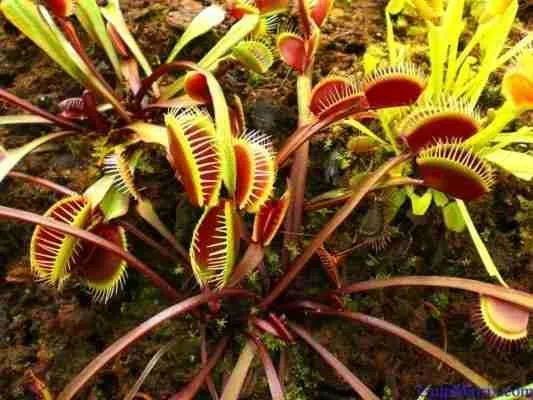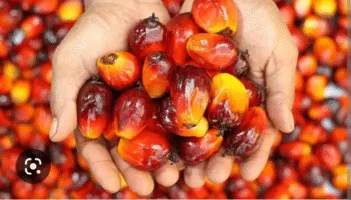Feeding Habit of Insectivorous Plants – Butterwort and Venus Fly

The feeding habit of insectivorous plants are clearly exemplified in how the Pinguicula Species Engulfs and Digests its Prey. The pinguicula is another genus of the Lentibulariaceae with three British species, Pinguicula vulgaris, Pinguicula lusitanica and Pinguicula grandiflora. In these three plants, the leaves are more or less radical and form a rosette. Each leaf is roughly oval in shape with inrolled margins. On the upper surfaces are borne long-stalked multicellular glands which secrete a sticky fluid, to which small animals adhere on contact.
Interspersed with these hairs are short stalked glands with usually about eight cells forming the head. These secrete a digestive fluid and the products of digestion of the animal’s body are absorbed through the leaf surface.
How the Dionaea Species Engulfs and Digests its Prey: Dionaea muscipula also known as the Venus fly-trap is a North American species of the family Droseraceae. It is probably the most widely known of all the insectivorous plants. In studying the feeding habit of this is insectivorous plants, we observe that the leaf again functions to trap the prey. It consists of a flattened petiole ending in a bi-lobed blade, the two halves of which of which from the midrib form an angle just over ninety degrees with one another. Each leaf lobe bears stiff bristle-like projections along its margin and on its upper surface three sensitive hair-like processes standing stiffly upwards. The upper surface also bears other smaller glandular structures which give it a reddish color.
Butterwort’s Feeding Habit Explained
The feeding habit of insectivorous plants such as the Butterworts is also very ok interesting. The Butterworts also known as pinguicula are a fascinating group of carnivorous plants in the genus Pinguicula that are known for their ability to trap insects. The upper surface of the plant’s basal rosette’s leaves appear to be covered in tiny, translucent hairs that secrete a sticky mucilage that smells like nectar and gleams with reflected sunlight, attracting insect prey. As insects land on the leaves, they become stuck in the mucilage and begin to suffocate; a second set of glands coat the trapped insect with enzymes that digest it. As the bug suffocates, its chitin skin falls off and is reabsorbed by the plant as a source of nutrients.
While most butterflies and moths are able to break free of the mucilage, many become so stuck that they lose a wing or two in their struggle. Butterworts are able to resorb the indigestible parts of their captured prey, as well as the nutrients they cannot ingest through the typically barren soils in which they grow. They also make use of the nitrogen that is present in the insects, and that is in part why they are considered both insectivorous and herbivorous plants.
Because the mucilage on the leaves is so sticky, it does not dry out easily. This is important, as a dry leaf surface will attract flies, which are a common pest of these plants in the wild. The plants have also evolved to produce a bacteria that prevents the insects from rotting while they are being digested. The mucilage also contains nutrients that the plant would otherwise be unable to absorb through its roots, and this is why some species of butterwort have adapted to sphagnum peat moss for growing media.
In addition to their natural insect-trapping abilities, butterworts have a wide range of other defensive mechanisms. Many plants can shoot toxins out from the leaf margins, which can repel or poison insect pests; others can emit an odor that is nauseating to insects. Some species of butterwort grow a sticky coating on their leaves that can deter snails and other small creatures that may try to eat them.
Most of the plants in the genus Pinguicula are found in meadows, bogs, pond edges and other moist places that are home to many insects. They are most often found in temperate climates, although a few species (P. lutea, P. neolepis) are native to Florida.
The genus is well-suited to indoor cultivation because of the relatively small root systems, which allow them to fit nicely into small containers and terrariums. The genus is also very easy to propagate, as it tends to form single-plant clusters that are ideal for cutting and transplanting. The plants can be grown from seed or by separating the individual flowers, which grow from short stalks at the top of the rosette. The flowers are a beautiful, vibrant blue or violet in color and are held away from the plants by long stalks. After flowering, the fruit ripens to brown and opens to reveal tiny brown seeds.
Venus FlyTrap Feeding Habit Explained
Venus fly traps, a member of the Droseraceae or sundew family, lure, trap, and digest insects for their nutrients. They are carnivorous perennial plants native to a small region in the southeastern United States, growing in coastal bogs.
They use specialized hair-like protrusions to sense movement. The traps will only close if two of the trigger hairs touch in rapid succession within 20 seconds. This is to avoid wasting energy closing on leaves or other inanimate objects.
Observations of the Feeding Habits of Insectivorous Plants
Venus flytraps are a type of carnivorous plant, but they don’t just consume their pollinators. They also use insects to ferry pollen, which helps fertilize other plants of the same species. The trap-like leaves secrete a sweet nectar that draws in insects searching for food.
In order for the plant to sense an insect and prepare to snap, three hair-like protrusions must be stimulated, called trichosomes. When a second movement is detected, the trigger hairs fire, flooding the trap’s lobes with calcium ions and snapping shut in under a second. Inanimate objects, such as twigs and rocks or a child sticking their pencil into the trap, can’t trigger the trap hairs because they don’t have an organic structure to cause them to move.
Charles Darwin raised the question of how Dionaea muscipula lures animal prey more than 140 years ago, but it remains unclear. In olfactory choice bioassays, the results suggest that over 60 volatile organic compounds (VOCs) emitted by the plant serve as a first signal attracting prey insects from distant locations and guiding them towards the deadly traps.
Feeding Habit of Insectivorous Plants
Unlike most plants, which draw sustenance from gases in the air and water in the soil through photosynthesis, Venus flytraps are carnivorous. They feed on insects, which they trap and digest to use as nutrients.
Normally, the trap’s trigger hairs must be stimulated by movement in order for the mouth to close. Leaves and twigs that fall into the trap or objects placed there (what child can resist sticking the tip of a pencil in a Venus flytrap to watch it snap shut?) don’t move enough to fire the trigger hairs, so the plant doesn’t waste energy closing on them.
Instead, the trap’s lobes seal together over the insect to create a “stomach,” which releases digestive enzymes that slowly eat the bug, and the hard exoskeleton blows away. It takes about 4-10 days for the trap to digest an insect. The nutrient-rich meal then becomes part of the plant’s root mass. The whole process seems to have worked just fine for the carnivorous Venus flytrap for millions of years.
Habitat
Venus fly traps are one of the most recognized carnivorous plants in the world. They grow in distinct longleaf pine habitats of the Coastal Plain and Sandhills of North Carolina and South Carolina.
Flies or other small insects that land on a Venus fly trap’s leaves are unable to escape because of its trigger hairs. When a trigger hair is touched, the plant snaps shut within about a tenth of a second. It then secretes digestive juices to digest the insect.
The Venus fly trap also uses its leaves to attract pollinators. NC State researchers Elsa Youngsteadt and Clyde Sorenson found that Venus flytrap flowers attract and pollinate bees and ants.
Venus flytraps are at risk in the wild from overcollection, habitat destruction and fire suppression. They are also at risk of extinction from development that drains their bog habitats. When purchasing Venus flytraps, make sure they are grown from tissue culture and not poached from the wild.
Breeding of Insectivorous Plants
Blowflies that are attracted to the bait station will then fly upward into a cone/funnel (wide at the bottom and narrowing to a small opening at the top) which leads into the holding compartment. Once inside, the flies find it difficult to escape. 5The trap secretes a digestive fluid that quickly begins to break down the hard exoskeleton of the insect, which releases protein molecules into the trap’s acidic bath.
The feeding habits of insectivorous plants is also well established in how the Venus flytrap gets a good deal of its sustenance from gases in the air and water in the soil, but it must also derive nitrogenous nutrients from other sources. It gets a good amount of these from insects.
Like many tropical plants, the genus Dionaea requires plenty of light. A Venus flytrap that gets a full six to 12 hours of sunlight each day will thrive. Insufficient lighting causes the leaves to yellow and wilt. Too much direct sun can scorch the leaves and damage the plant.


